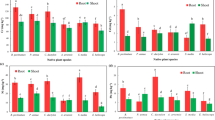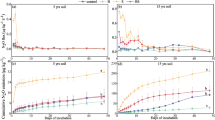Abstract
The importance of assessing the impacts of soil arsenic (As) contamination on microbial properties lay on the fact that microbes are instrumental in nutrient cycling and are therefore indicators of soil quality. In this study, soil chemical extraction methods were used to extract labile and freely exchangeable As (water-soluble As and sodium bicarbonate-extractable As), amorphous/crystalline Fe and Mn oxide-bound As (acid ammonium oxalate-extractable As and hydroxylamine hydrochloride-extractable As), and their impacts on microbial biomass (microbial biomass C, total bacterial and fungal biomass, active bacterial and fungal biomass), enzyme activities representing four major soil biogeochemical cycles, i.e., C (β-glucosidase activity), N (urease activity), P (acid phosphomonoesterase activity), S (acryl-sulfatase activity), and microbial activity (fluorescein diacetate hydrolysis and dehydrogenase activity) were investigated in As-contaminated soils of Ambagarh Chauki block, Chhattisgarh, Central India. The results revealed that the majority of the As in soils resided in the Fe/Mn oxide-bound fraction. The microbial biomass C, total and active fungal biomass, and enzyme activities were significantly inhibited by all the forms of As. However, water-soluble As, even though occupying only a small portion of the total As (0.9–2.9 %), exerted the greatest impact. Interestingly, total and active bacterial biomass was not significantly affected by As toxicity, suggesting their resistance to As. Urease activity was not affected by As pollution.


Similar content being viewed by others
References
Acharyya SK, Shah BA, Ashyiya ID, Pandey Y (2005) Arsenic contamination in groundwater from parts of Ambagarh-Chowki block, Chhattisgarh, India: source and release mechanism. Environ Geol 49:148–158
Adam G, Duncan H (2001) Development of a sensitive and rapid method for the measurement of total microbial activity using fluorescein diacetate (FDA) in a range of soils. Soil Biol Biochem 33:943–951
Bardgett R, Speir DTW, Ross DJ, Yeates GW, Kettles HA (1994) Impact of pasture contamination by copper, chromium, and arsenic timber preservative on soil microbial properties and nematodes. Biol Fert Soils 18:71–79
Bhattacharyya P, Tripathy S, Kim K, Kim SH (2008) Arsenic fractions and enzyme activities in arsenic-contaminated soils by groundwater irrigation in West Bengal. Ecotoxicol Environ Saf 71:149–156
Bottomley PJ (1994) Light microscopic methods for studying soil microorganisms. In: Weaver RW (ed) Methods of soil analysis, part 2, microbiological and biochemical properties. Soil Sci Soc of America, Madison, WI, pp 81–105
Bremmer JM, Mulvaney CS (1982) Nitrogen—total. In: Page AL, Miller RH, Keeney DR (eds) Methods of soil analysis, part 2—chemical and microbiological properties. ASA-SSSA, Madison, pp 595–624
Brookes PC (1995) The use of microbial parameters in monitoring soil pollution. Biol Fert Soils 19:269–279
Busse MD, Sanchez FG, Ratcliff AW, Butnor JR, Carter EA, Powers RF (2009) Soil carbon sequestration and changes in fungal and bacterial biomass following incorporation of forest residues. Soil Biol Biochem 41:220–227
Chaparro JM, Sheflin AM, Manter DK, Vivanco JM (2012) Manipulating the soil microbiome to increase soil health and plant fertility. Biol Fertil Soils 48:489–499
Chendrayan K, Adhya TK, Sethunathan N (1980) Dehydrogenase and invertase activities of flooded soil. Soil Biol Biochem 12:271–273
Codling E (2011) Environmental impact and remediation of residual lead and arsenic pesticides in soil. In: Stoytcheva M (ed) Pesticides in the modern world—risks and benefits. InTech, New York, pp 169–180, ISBN: 978-953-307-458-0
Edvantoro BB, Naidu R, Megharaj M, Singletona I (2003) Changes in microbial properties associated with long-term arsenic and DDT contaminated soils at disused cattle dipsites. Ecotox Environ Safe 55:344–351
Eivazi F, Tabatabai MA (1977) Phosphates in soils. Soil Biol Biochem 9:167–172
Eivazi F, Tabatabai MA (1998) Glucosidases and galactosidases in soils. Soil Biol Biochem 20:601–606
Fernandez P, Sommer I, Cram S, Rosas I, Gutierrez M (2005) The influence of water-soluble As(III) and As(V) on dehydrogenase activity in soils affected by mine tailings. Sci Total Environ 348:231–243
Garau G, Silvetti M, Deiana S, Deiana P, Castaldi P (2011) Long-term influence of red mud on As mobility and soil physico-chemical and microbial parameters in a polluted sub-acidic soil. J Hazard Mater 185:1241–1248
Ghosh AK, Bhattacharyyaa P, Pal R (2004) Effect of arsenic contamination on microbial biomass and its activities in arsenic contaminated soils of Gangetic West Bengal, India. Environ Int 30:491–499
Girouard E, Zagury GJ (2009) Arsenic bioaccessibility in CCA-contaminated soils: influence of soil properties, arsenic fractionation, and particle-size fraction. Sci Total Environ 407:2576–2585
Johnson SE, Barnard WM (1997) Comparative effectiveness of fourteen solutions for extracting arsenic from four western New York soils. Soil Sci Soc Am J 43:304–308
Joynt J, Bischoff M, Turco R, Konopka A, Nakatsu CH (2006) Microbial community analysis of soils contaminated with lead, chromium and petroleum hydrocarbons. Microb Ecol 51:209–219
Lorenz N, Hintemann T, Kramarewa T, Katayama A, Yasuta T, Marschner P, Kandeler E (2006) Response of microbial activity and microbial community composition in soils to long-term arsenic and cadmium exposure. Soil Biol Biochem 38:1430–1437
Luna GM, Manini E, Danovaro R (2002) Large fraction of dead and inactive bacteria in coastal marine sediments: comparison of protocols for determination and ecological significance. Appl Environ Microbiol 68:3509–3513
McLaren RG, Naidu R, Smith J, Tiller KG (1998) Fractionation and distribution of arsenic in soils contaminated by cattle dip. J Environ Qual 27:348–354
Nannipieri P, Giagnoni L, Landi L, Renella G (2011) Role of phosphatase enzymes in soil. In: Bunemann EK, Oberson A, Frossard E (eds) Phosphorus in action. Soil biology 26. Springer, Berlin, pp 215–241
Nannipieri P, Giagnoni L, Renella G, Puglisi E, Ceccanti B, Masciandaro G, Fornasier F, Moscatelli MC, Marinari S (2012) Soil enzymology: classical and molecular approaches. Biol Fertil Soils 48:743–762
Nannipieri P, Kandeler E, Ruggiero P (2002) Enzyme activity as monitors of soil microbial functional diversity. In: Burns RG, Dick R (eds) Enzymes in the environment: activity, ecology and applications. Marcel Dekker, New York, pp 1–34
O’Neil P (1995) Heavy metals in soils. In: Alloway BJ (ed) Arsenic. Blackie Academic and Professional, London, pp 105–121
Patel KS, Shrivas K, Brandt R, Jakubowski N, Corns W, Hoffmann P (2005) Arsenic contamination in water, soil, sediment and rice of central India. Environ Geochem Health 27:131–145
Reza SAHM, Jean JS, Lee MK, Yang HJ, Liu CC (2010) Arsenic enrichment and mobilization in the Holocene alluvial aquifers of the Chapai-Nawabganj district, Bangladesh: a geochemical and statistical study. Appl Geochem 25:1280–1289
Rodriguez RR, Basta NT, Casteel SW, Armstrong FP, Ward DC (2003) Chemical extraction methods to assess bioavailable arsenic in soil and solid media. J Environ Qual 32:876–884
Shukla DP, Dubey CS, Singh NP, Tajbakhsh M, Chaudhry M (2010) Sources and controls of Arsenic contamination in groundwater of Rajnandgaon and Kanker District, Chattisgarh Central India. J Hydrol 395:49–66
Smith E, Naidu R, Weber J, Juhasz AL (2008) The impact of sequestration on the bioaccessibility of arsenic in long-term contaminated soils. Chemosphere 71:773–780
Tabatabai MA (1977) Effects of trace elements on urease activity in soils. Soil Biol Biochem 9:9–13
Tabatabai MA, Bremner JM (1970) Aryl sulphatase activity of soils. Soil Sci Soc Am J 34:225–229
Tabatabai MA, Dick WA (2002) Enzymes in soil. In: Burns RG, Dick R (eds) Enzymes in the environment: activity, ecology and applications. Marcel Dekker, New York, pp 1–34
Vance ED, Brookes PC, Jenkinson DS (1987) An extraction method for measuring soil microbial biomass. Soil Sci Plant Nutr 19:703–707
Wanga F, Yaoa J, Si Y, Chena H, Russela M, Chena K, Qiana Y, Zarayb G, Bramantic E (2010) Short-time effect of heavy metals upon microbial community activity. J Hazard Mater 173:510–516
Yang JK, Barnett MO, Jardine PM, Basta NT, Casteel SW (2002) Adsorption, sequestration, and bioaccessibility of as(V) in soils. Environ Sci Technol 36:4562–4569
Acknowledgments
This work was partially supported by the National Science Council of Taiwan (project grant no. NSC 100–2116–M–006-009). The authors are grateful to Mr. Pramod Joshi for his help and assistance during field sampling. Due appreciation is given to Prof. Paolo Nannipieri for helping with the editing of the manuscript.
Author information
Authors and Affiliations
Corresponding authors
Rights and permissions
About this article
Cite this article
Das, S., Jean, JS., Kar, S. et al. Effect of arsenic contamination on bacterial and fungal biomass and enzyme activities in tropical arsenic-contaminated soils. Biol Fertil Soils 49, 757–765 (2013). https://doi.org/10.1007/s00374-012-0769-z
Received:
Revised:
Accepted:
Published:
Issue Date:
DOI: https://doi.org/10.1007/s00374-012-0769-z




